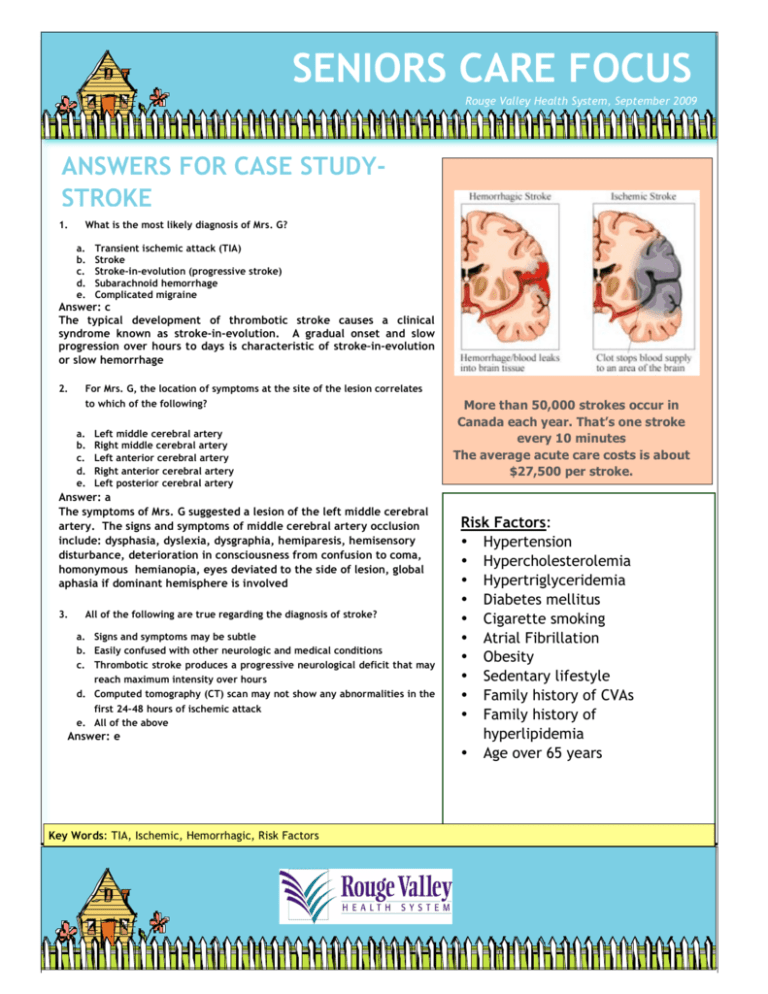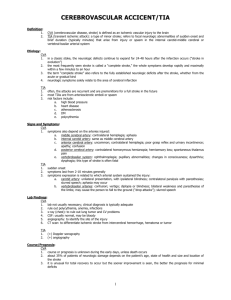Newsletter Seniors Care Focus stroke answer
advertisement

SENIORS CARE FOCUS Rouge Valley Health System, September 2009 ANSWERS FOR CASE STUDYSTROKE 1. What is the most likely diagnosis of Mrs. G? a. b. c. d. e. Transient ischemic attack (TIA) Stroke Stroke-in-evolution (progressive stroke) Subarachnoid hemorrhage Complicated migraine Answer: c The typical development of thrombotic stroke causes a clinical syndrome known as stroke-in-evolution. A gradual onset and slow progression over hours to days is characteristic of stroke–in-evolution or slow hemorrhage 2. For Mrs. G, the location of symptoms at the site of the lesion correlates to which of the following? a. b. c. d. e. Left middle cerebral artery Right middle cerebral artery Left anterior cerebral artery Right anterior cerebral artery Left posterior cerebral artery Answer: a The symptoms of Mrs. G suggested a lesion of the left middle cerebral artery. The signs and symptoms of middle cerebral artery occlusion include: dysphasia, dyslexia, dysgraphia, hemiparesis, hemisensory disturbance, deterioration in consciousness from confusion to coma, homonymous hemianopia, eyes deviated to the side of lesion, global aphasia if dominant hemisphere is involved 3. All of the following are true regarding the diagnosis of stroke? a. Signs and symptoms may be subtle b. Easily confused with other neurologic and medical conditions c. Thrombotic stroke produces a progressive neurological deficit that may reach maximum intensity over hours d. Computed tomography (CT) scan may not show any abnormalities in the first 24-48 hours of ischemic attack e. All of the above Answer: e Key Words: TIA, Ischemic, Hemorrhagic, Risk Factors More than 50,000 strokes occur in Canada each year. That’s one stroke every 10 minutes The average acute care costs is about $27,500 per stroke. Risk Factors: • Hypertension • Hypercholesterolemia • Hypertriglyceridemia • Diabetes mellitus • Cigarette smoking • Atrial Fibrillation • Obesity • Sedentary lifestyle • Family history of CVAs • Family history of hyperlipidemia • Age over 65 years SENIORS CARE FOCUS PAGE 2 4. Which one of the following is true about the acute management of stroke? a. There is no evidence that admission of TIA patient improves outcomes as long as there is general medical follow-up b. Blood pressure elevations should be treated once systolic reaches 150mm Hg or diastolic reaches 100mm Hg to preserve brain tissue and prevent poor stroke outcomes in the immediate post stroke period c. Heparin should be used for treatment of moderate to severe hemispheric strokes d. Aspirin at a dosage of 160 to 325mg should be administered in the first 24 to 48 hours to decrease the likelihood of recurrent stroke, providing there are no contraindications e. All of the above Answer: d After a TIA, the risk of a stroke within the next 10 days is 8%. The elevation of blood pressure after ischemic stroke may be a physiologic response to increased cerebral perfusion pressure to preserve neurological tissue and minimize neuronal damage in the peri-infract areas. 5. In which of the following conditions would you most likely find an embolic phenomena as the pathophysiology of a CVA? a. Hypertension b. Atrial fibrillation c. Ventricular fibrillation d. A and b e. All of the above Answer: b Conditions associated with an embolic stroke include: atrial fibrillation, myocardial infarction, endocarditis, rheumatic heart disease, valvular prostheses, disorders of aorta or carotids, and other embolic phenomena such as air, fat, and tumor 6. Which of the following is not a common post stroke complication that should be monitored? a. Depression b. Urinary incontinence c. Swallowing problem and choking d. Falls e. Diarrhea Answer: e 7. What is the number one risk factor for CVA? a. Cigarette smoking b. Hypertension c. Hypercholesterolemia d. Hypertriglyceridemia e. Hypothyroidism Answer: b The single most important risk factor for stroke is hypertension. Other important risk factors include: age, heart disease, cigarette smoking, diabetes mellitus, and family history of lipid disorder or cardiovascular diseases. 8. All of the following are treatment and management considerations for acute stroke except: a. Hyperglycemia should be aggressively treated in the acute stroke period because elevated blood glucose has been associated with poor neurologic outcomes b. For patients with major stroke with immobility, deep venous prophylaxis should be provided by the use of heparin, or compression stockings c. Indwelling urinary catheter should be used in incontinent patient with impaired mobility to prevent urinary tract infections d. Speech language pathologist evaluate swallowing for aspiration risk e. Physical and occupational therapist to assess rehabilitation needs and plan Answer: c References: 1. 2. 3. Ham, R. J. , Sloane, P. D., Warshaw, G. A., Bernard, M. A. & Flaherty e. (2007) Primary care geriatrics: A case-based approach 5th ed. Mosby U. S. A. Heart and Stroke Foundation retrieved from www.heartand stroke.com (2009) Tallia, A. F., Cardone, D. A., Howarth, D. F. & Ibsen, K. H. (2001) Family practice review: A problem-oriented approach. 4th ed. Kaplan Medical, Mosby. Clara Tsang RN (EC) Emergency Department Rouge Valley Health System 416-284-8131 Ext. 4692 E-mail:ctsang@rougevalley.ca








